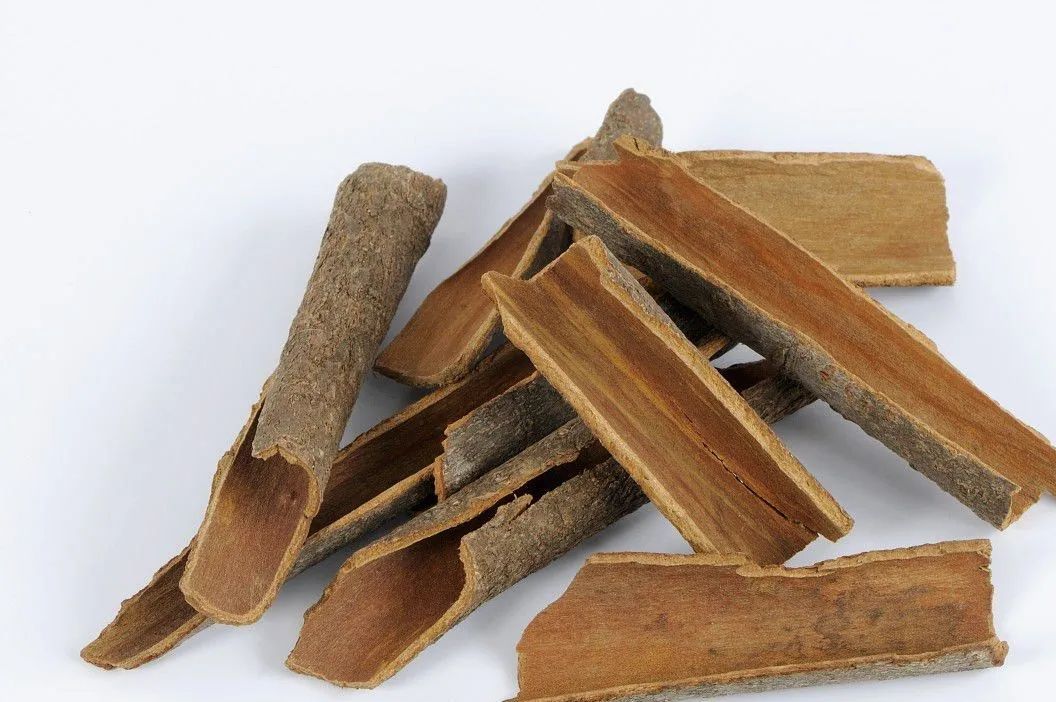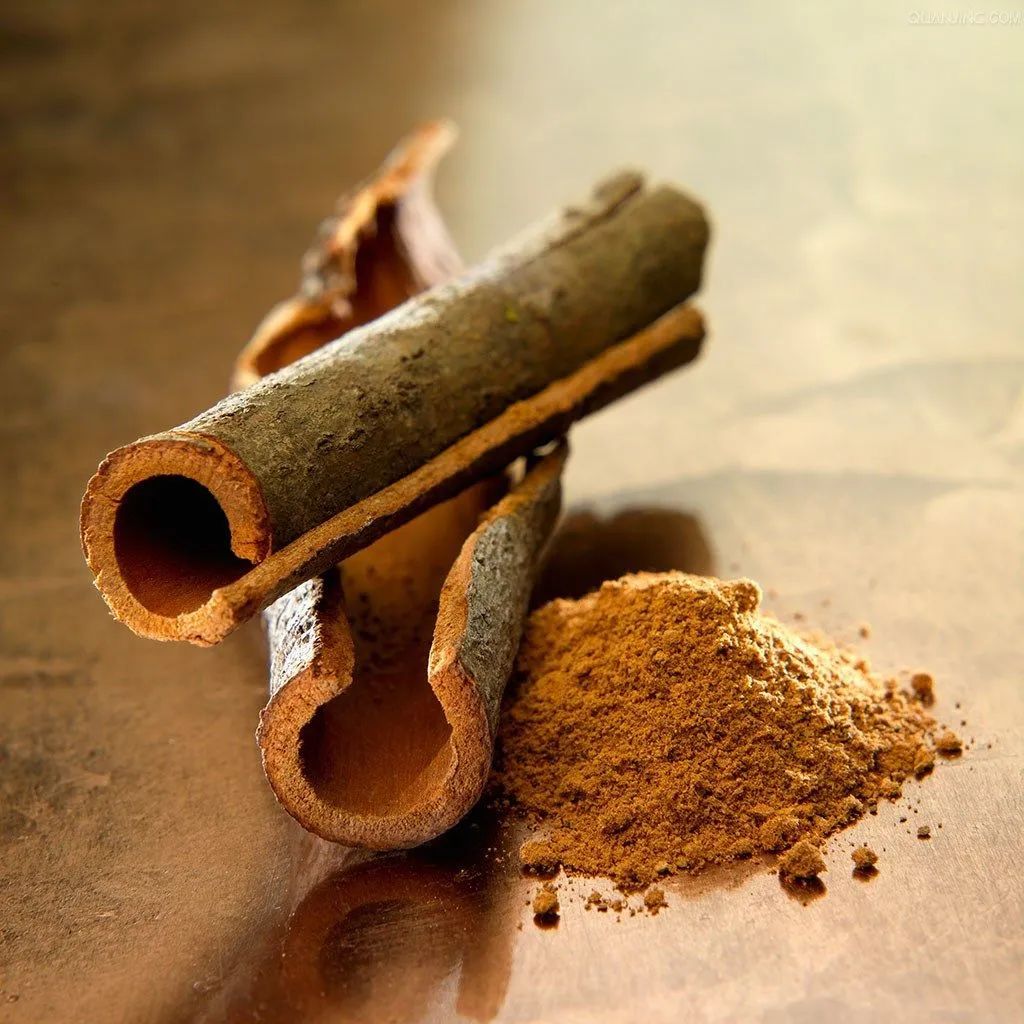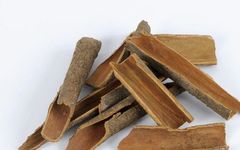Cinnamon (Rou Gui)

Cinnamon is derived from the dried bark of the plant Cinnamomum cassia Presl, belonging to the Lauraceae family.
It is typically harvested in the autumn and dried in the shade.
Classical Text References

Shen Nong’s Herbal Classic: “It is used for cough due to qi deficiency, throat obstruction, and to benefit joints, tonify the middle and augment qi.”
Prescriptions of Famous Doctors: “It is used for heart pain, wind in the flanks, flank pain, warming the tendons, unblocking the meridians, stopping restlessness, and sweating. It is also used for warming the middle, benefiting liver and lung qi, treating cold and heat in the heart and abdomen, cholera, cramping, headaches, lower back pain, stopping salivation, cough, and nasal congestion; it can induce abortion, strengthen bones and joints, unblock blood vessels, and regulate insufficiencies; it promotes the efficacy of all medicines without fear.”
Discussion on Medicinal Properties: “It treats nine types of heart pain, kills three types of parasites, breaks blood stagnation, unblocks menstrual issues, treats soft feet, numbness, retained placenta, relieves cough, resolves qi stagnation, and abdominal cold pain, and is effective for diarrhea and nasal polyps. It also eliminates plant and wood toxins.”
Various Herbal Compendiums: “It treats all types of wind conditions, tonifies the five fatigues and seven injuries, opens the nine orifices, benefits joints, enhances essence, brightens the eyes, warms the lower back and knees, breaks up phlegm and blood stasis, and treats wind bi syndrome and joint contractions, and promotes muscle growth.”
Precious Pearl Bag: “It expels wind evil from the body, alleviating lower abdominal pain in autumn and winter.”
Medical Origins: “It tonifies the lower jiao deficiency, treats cold shoulders and spontaneous sweating due to exterior deficiency.”
Essential Prescriptions: “It promotes diuresis and alleviates thirst.”
Principles of Medicinal Use: “It counters cold evils and treats running piglet syndrome.”
Compendium of Materia Medica: “It treats cold bi syndrome, wind darkness, yin excess with blood loss, diarrhea, and shock. It treats yang deficiency with blood loss, internal abscesses, and can draw blood to transform sweat and pus, and neutralize snake venom.”
Identification Points
(1) It is shaped like a trough or rolled tube.(2) The outer surface is gray-brown with fine longitudinal lines and transverse raised pores, with some showing gray-white lichen spots. The inner surface is reddish-brown, slightly smooth, with fine longitudinal lines, and shows oil marks when scratched.(3) It is hard and brittle, with a granular fracture surface; the outer layer is brown, the inner layer is reddish-brown and oily, with a yellow-brown line in the middle.(4) It has a strong aroma, with a sweet and spicy taste.
Traditional experience suggests that the best quality has a thin skin, thick flesh, high oil content, strong aroma, sweet and spicy taste, and leaves little residue when chewed.
Consumption Guidelines
Traditional Chinese Medicine considers cinnamon to have a spicy and sweet flavor, and is very warming; it enters the stomach, kidney, heart, and liver meridians. It has the effects of tonifying fire and assisting yang, guiding fire back to the source, dispersing cold and alleviating pain, and warming and unblocking the meridians. It is effective for impotence due to cold in the uterus, cold pain in the lower back and knees, kidney deficiency with wheezing, floating yang, dizziness, red eyes, cold pain in the heart and abdomen, cold vomiting and diarrhea, cold hernia abdominal pain, and dysmenorrhea. Caution is advised for those with a tendency to bleed and for pregnant women; it should not be used with red stone fat.
1. Cinnamon Powder
【Formula】3 grams of cinnamon bark.
【Preparation】Grind into a fine powder.
【Usage】Take twice daily with warm water.
【Function】It can treat gastric distension and cold pain; adding cinnamon powder to vegetables during cooking can help control blood sugar and cholesterol.
2. Cinnamon Brown Sugar Tea
【Formula】3-6 grams of cinnamon bark, 12 grams of brown sugar.
【Preparation】Boil cinnamon in water, strain, and add brown sugar for later use.
【Usage】Take in two doses warm.
【Function】It can treat abdominal pain after childbirth in women.
3. Cinnamon Hawthorn Tea
【Formula】3 grams of cinnamon, 9 grams of hawthorn flesh, 30 grams of brown sugar.
【Preparation】Boil the first two ingredients in an appropriate amount of water for three to five minutes, strain, and add brown sugar for later use.
【Usage】Take in two doses before menstruation.
【Function】It can treat abdominal distension and pain during menstruation.
4. Cinnamon Chicken Liver Soup (from Compendium of Materia Medica)
【Formula】15 grams of cinnamon, 100 grams of chicken liver, appropriate amount of salt.
【Preparation】Wash the cinnamon and chicken liver, marinate the chicken liver with a little salt, then place it with the cinnamon in a pot, add an appropriate amount of water, and simmer until cooked, removing the cinnamon afterward.
【Usage】Take one dose daily, at any time with chicken liver soup.
【Function】It warms and tonifies the liver and kidneys, nourishes blood, and brightens the eyes. It can be used for nutritional anemia, vision decline in the elderly, and presbyopia.
5. Cinnamon Wine (from Food and Herbal Classics)
【Formula】20 grams of cinnamon, 1000 milliliters of white liquor.
【Preparation】Wash the cinnamon, dry it, grind it into a fine powder, sift it, place it in a wine bottle, seal it, and soak for 15 days before opening for use.
【Usage】Drink 10-15 milliliters each time, 1-2 times daily.
【Function】It warms the kidneys, assists yang, disperses cold, and alleviates pain.
Note: The white liquor used should be high-quality sorghum liquor with an alcohol content of 45-50 degrees.
Consumption Contraindications
Those with yin deficiency and excess fire should avoid it, and pregnant women should use caution. Prescriptions of Famous Doctors: “If combined with ginseng, licorice, ophiopogon, rhubarb, and scutellaria, it can tonify the middle and augment qi; if combined with bupleurum, purple quartz, and rehmannia, it can treat nausea and vomiting.” Herbal Pairings: “Avoid with red stone fat.” Shen Nong’s Herbal Classic Commentary: “It is contraindicated for conditions such as blood collapse, blood in urine, yin deficiency with vomiting blood, nasal bleeding, and other heat-related symptoms.” Compendium of Materia Medica: “Avoid exposure to fire.” Herbal Pairings: “It is contraindicated for phlegm cough, throat pain, blood deficiency with internal dryness, pregnant women, and postpartum heat.” Herbal Truths: “It is strictly contraindicated for those with deficiency of essence and blood, and excessive liver fire.”
Special Statement
Non-clinical practitioners should not self-medicate to avoid adverse outcomes. Patients must use medications under the guidance of a clinical physician.
-END-
Image materials sourced from the internet; if there are copyright issues, please contact this account for timely deletion.
Purchase channels
National Xinhua Bookstore
Professional medical bookstores
Major websites like JD, Dangdang, etc.


